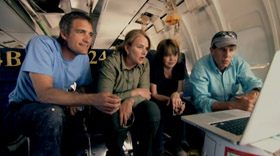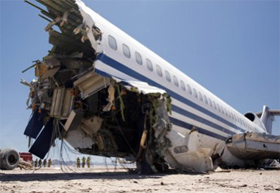Scientists Crash a Plane in the Name of Safety
-
-
slice.mit.edu
- 4
Filed Under
Recommended

What really happens during a plane crash? Could you survive? That's what the Discovery Channel show Curiosity sought to find out recently. So they enlisted the help of an expendable Boeing 727 and several researchers—one of whom was Aero/astro Professor R. John Hansman Jr. SM '80, PhD '82. Hansman heads the Division of Humans and Automation and directs the International Center for Air Transportation.
The crash took place in a remote part of the Sonoran Desert of Baja California, Mexico. To "safely" crash the plane, the crew parachuted out then a former Navy test pilot in a nearby plane took over via remote control. The 727 hit the ground at 140 mph, close to regular landing speed, but after descending 1,500 feet per minute, much faster than the 10 to 20 feet per minute of a typical airliner landing. The crash mimicked two others (in 2008 and 2009) in which a plane lost speed and power just before landing hard and breaking into pieces. Read more in USA Today's documentation of the crash.
 Cameras capturing all angles (one was even in the ejecting pilot's helmet), sensors, and crash-test dummies recorded the event. The results? The plane's design is sound, Hansman told USA Today. And wearing seatbelts and properly bracing for a crash are very important. But there's bad news if you fly first class. In this crash, at least, those passengers would have died. Seat 7A even catapulted 500 feet from the plane. People in the back of the plane could have walked away. Travelers in the middle of the cabin might have suffered concussions and broken bones. The pilots could have survived though the cockpit was extensively damaged.
Cameras capturing all angles (one was even in the ejecting pilot's helmet), sensors, and crash-test dummies recorded the event. The results? The plane's design is sound, Hansman told USA Today. And wearing seatbelts and properly bracing for a crash are very important. But there's bad news if you fly first class. In this crash, at least, those passengers would have died. Seat 7A even catapulted 500 feet from the plane. People in the back of the plane could have walked away. Travelers in the middle of the cabin might have suffered concussions and broken bones. The pilots could have survived though the cockpit was extensively damaged.
"If you were to take a flight every day, in order for you statistically to be in a fatal aircraft accident, you'd have to live 35,000 years….There is no other means of transportation that is equivalent in terms of its success. It's actually much safer than riding on an escalator." --R. John Hansman in USA Today.Scientists hope the data will help them improve aviation safety. The amount of dust that rushed into the cabin and obscured exits is one thing scientists will look to minimize in the future, for example.
The video here shows much of the crash, but view more videos of the experiment on the Curiosity website. The episode will be rebroadcast tonight, tomorrow, and on Oct. 14. And if you're interested in Hansman's research, he and colleagues in Spain recently created a new tool to analyze black-box data for flight anomalies that can help airlines improve aircraft safety and operations.
Discover Channel Taps Experts with MIT Ties
The Curiosity website features numerous experts—many of them alumni and/or professors—on a variety of topics. Here are just some:Computers: Rosalind W. Picard SM '86, ScD '91 (MIT media arts and sciences professor); Leonard Kleinrock SM '59, PhD '63
Communications: Brewster Kahle '82, Joi Ito (Media Lab head), Megan Smith '86, SM '88
Culture and History: Peter Diamandis '83, SM '88
Education: Mitchel Resnick SM '88, PhD '92 (head of the Media Lab's Lifelong Kindergarten group)
Physics: Robert Metcalfe '68
Robotics and Artificial Intelligence: Colin Angle '89, SM '91
Science and Society: Alex Sandy Pentland PhD '82 (MIT media arts and sciences professor), Daniel Hillis '78, SM '81, PhD '88
Space Exploration: Michael Massimino SM '88, ME '90, ENG '90, PhD '92








Comments
mtubuzz
Mon, 03/17/2014 1:32am
I saw this episode of Boeing 727 on Discovery Channel, that was a dreadful incident. Though, It was wonderfully showed up by the Discovery team.
tracey
Mon, 10/15/2012 1:34pm
Just watched The Plane Crash on channel 4. Very interesting programme. I would like to no what position would be recommend when you had you toddler strapped onto you. Would you not crush your child in the brace position? Thanks. Tracey
khan
Mon, 10/15/2012 5:10am
Interesting research the clips you show us are very informative
Dad
Fri, 10/12/2012 1:25pm
Ouch! ... but very interesting; and there's a whole series of clips here.
Fly safe,
Dad